You might have seen several pet shops that keep frogs and turtles together in the tank. These two creatures are definitely a treat to have in your tank. However, you may have often wondered if you can keep these two creatures together under the same roof. The answer to this question is quite complicated. Several factors determine if frogs and turtles can actually live together. Frogs and turtles are like cats and mice under the same roof. They can live together, but they can also be troublesome. In this article, we will dwell into the question deeper and answer all of your questions related to this. So, read on!
Table of Contents
Can frogs and turtles live together?

When they’re in their habitat, which is water, aquatic turtles are quicker than frogs. If they are kept together, they will assault and consume your frog.
On the other hand, frogs and turtles have a good chance of coexisting in the wild.
If they come into contact, the frog will have a lower possibility of surviving. Hence, you would be the one to pay the price. A turtle’s robust defense will protect the turtle from the frog’s attacks even when the frog strikes back. A turtle’s massive biting force will shred a frog’s fragile skin off. This also depends on how big these pets are. For example, if your cat is more powerful than your turtle, then your turtle is less likely to attack the cat.
It is interesting to note that frogs are also predators. Hence, they can also attack your turtles. Turtle shells are heavier than frog shells, despite their shorter length. This makes it difficult for frogs to squeeze them into their mouth. There are some other factors that can determine if frogs and turtles can live together. They are as follows:
1. Tank Space
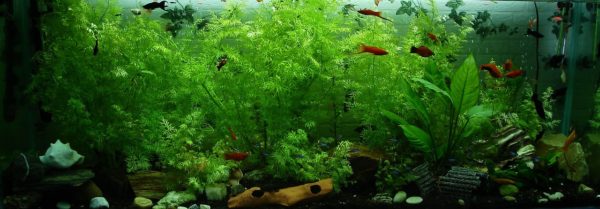
The majority of tanks are insufficiently large to allow frogs and turtles to coexist harmoniously. Both species require a large amount of room in which to swim, forage, and hide. They must also be able to participate in such activities without colliding with one another. In a tank, this is difficult to achieve. The animals would become anxious. To feel comfortable and protected, frogs and turtles need hiding places in their habitat. Due to the restricted area in a tank, it might be difficult to provide adequate hiding locations for each species. Frogs and turtles cannot be housed together in tanks as they’re too tiny of a habitat. The animals will become anxious if they do not have adequate space.
2. Stress
The frog and turtle may hesitate to fight if their sizes are similar. Nevertheless, the animals will continue to compete for the pet owner’s food. This rivalry might cause tension and lead to an attack over time. A predator-prey connection will most likely form if one species is significantly larger than the other. This will result in stress and assault. Because they won’t be able to hide or outswim one another if there isn’t enough room. The animals will struggle to avoid conflict. Both animals will get weaker as a result of prolonged stress. This will render them more vulnerable to death and injury.
3. Tank parameters
Frogs and turtles require different types of tanks. Turtles require far larger tanks than other frog species and significantly more water. A turtle aquarium should have a minimum of 15 gallons of water. If the tank has more than one turtle, the water level ought to be up to 20 gallons per inch of turtle.
Turtles have been known to burrow and eat live plants. This quickly contaminates their water. They soon leave a waste build-up in any substrate at the tank’s bottom. For most frog species, this is not an optimal habitat. They require substantially less water. Hence, they hide among the foliage and burrow in the substrate.
4. Food
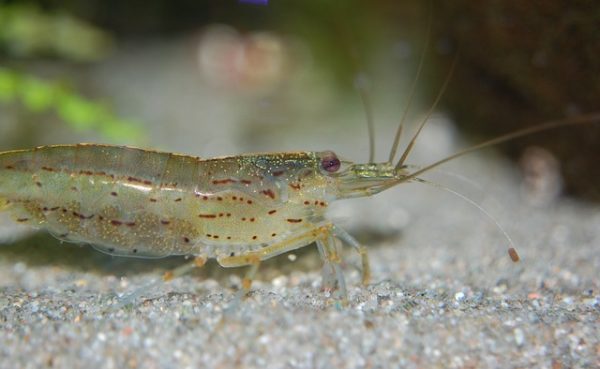
Turtles are omnivorous and thrive on a diet consisting of both vegetation and live prey. Crickets, shrimp, tiny fish, and worms are instances of live prey for turtles.
Frogs are opportunistic feeders and general carnivores. Live crickets, grasshoppers, locusts, and mealworms are part of their diet. Pellet food is another alternative. Frogs and turtles may both eat pellets. It allows the animals to hunt in the same way they would have in the wild. This form of enrichment will improve your pets’ quality of life. It’s also important to think about the best feeding plan for every one of your animals. Some animals require feeding every several hours or so. Some animals just require feeding every few days. The breed’s specific needs must determine the frequency with which you feed your animals. A regular food regimen suited to each breed’s demands is an essential part of successful pet ownership.
Frogs and turtles have similar food requirements. However, this is not the case for many breeds. If you keep your animals in the same tank, one or more of them may get overfed or underfed as a result. The quantity of food and the regularity with which both species are fed is determined by the animal’s breed. It’s ideal to maintain frogs and turtles in separate aquariums. This is so that they may eat the healthiest food possible.
Why should you not keep frogs and turtles together?
To begin with, turtles have various needs than frogs. Although their lifestyles are similar, they do not require the same items. Second, turtles have murderous tendencies that are hard to control, if not impossible. They have the desire to murder other living creatures since they regard them as prey. Having a turtle and a frog in the same aquarium may thus resemble a scene from a horror film. It will lead to a case where the frog is murdered and eaten by the turtle.
In addition, the elements affecting their living conditions differ. They require varying water temperatures, foods, and quantities of water.
Turtles, for example, require enclosures with a water storage capacity of 25 to 50 gallons. They also require surfaces above the water, such as ponds, sand, or platforms. This allows them to dry off completely. Frogs are not as ostentatious as turtles. But, their skin contains poisons that might harm or even kill turtles. Considering these circumstances, it’s simple to see how a turtle would kill the frog and die as a result of the frog’s poison. The contradiction between them is, in the end, fatal.
Even though you succeed in having a frog and a turtle around the same size, the stress and competitiveness in their habitat may be enough to impact the comfort level of either animal. Frogs and turtles consume snails, mealworms, grasshoppers, and crickets, which are the same insects that turtles eat. As a result, every time your pets eat, it’ll be like witnessing a barbarian fight where the winner takes everything. If a dominant position is maintained, the loser will face anxiety and famine.
Which Is The Likely Winner? Frog or Turtle?
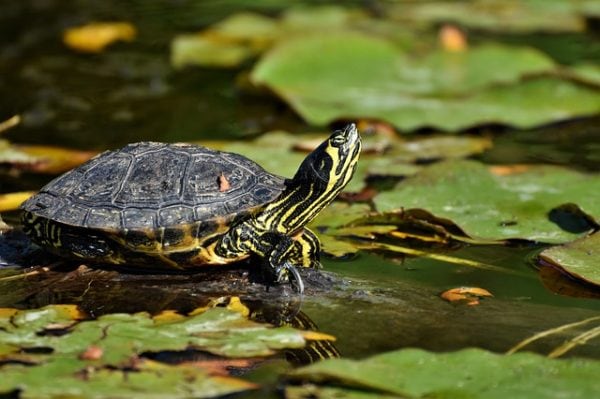
When you study the food chain, you may notice that many turtle species like eating frogs and toads. Turtles and frogs are generally omnivores. This means they eat both plant and animal-based protein (or insects). Both of these animals are opportunistic killers. This means they will consume almost everything they can get their hands on.
Turtles eat frogs like the common snapping turtle and the alligator snapping turtle in the wild. Frogs are food for most types of turtles, as previously stated in the food chain of turtles and frogs. Aquatic turtles are quicker in the water. Keeping a frog with a marine turtle might jeopardize their life.
If your pet frog is much smaller than your turtle, you may have to see the slaughter of your poor frog. In comparison, if your frog is more significant than your turtle, there’s a good chance that your frog will eat your turtle. Species of giant frogs commonly eat turtles. For example, the Argentine horned frog and the African bullfrog.
The turtle is more likely to win since turtles are bigger. This is if they have been housed together. The Argentine Horned Frog and the African Bullfrog are two huge frog species. If the turtles are tiny enough, they have been expected to eat them.
Turtles, on the other hand, are often bigger animals. They are more likely to defeat a frog. Turtles have the advantage of size, as well as the protection of their shell. The turtle’s shell covers much of the turtle’s body. Hence, it’s tough for the frog to attack successfully. Furthermore, turtles have a powerful bite that may easily rip a frog’s skin. Turtles are also the most likely winners because of their speed. They can easily outswim frogs. The frog will have restricted hiding areas and little hope of escaping in a tank. In comparison, if the frog is bigger than the turtle. Hence, the turtle will be less likely to attack. The frog could have a chance if it could eat the turtle whole. It’s also important to know if a certain frog breed is hazardous. Toxins are produced by certain frogs, such as Pickerel Frogs. If a turtle consumes the frog, it will be poisoned and die. Nobody wins in this instance.
Therefore, in such a complex situation, we cannot say who the winner or loser is in such a tricky situation. Frogs and turtles have their requirements and preferences, making it problematic to have these two living under the same roof.
Can Frogs and Turtles Live Together in A Pond?
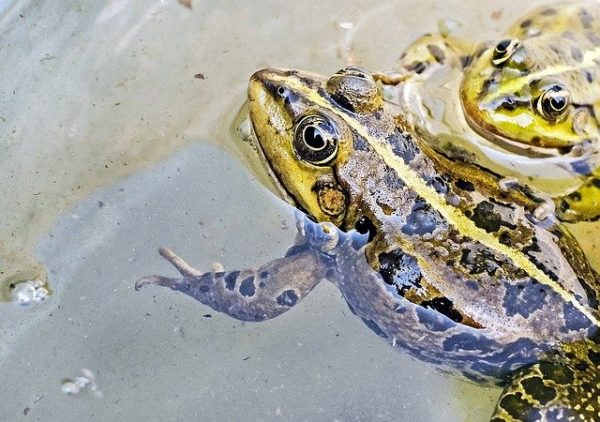
Having enough foliage and plants can help keep frogs and turtles in the same pond. This provides them with hiding spaces.
Before putting these two critters in an outdoor pond, there are a few things to think about. There are a few things to think about. They are as follows:
1. Vegetation
Fill the pond with several aquatic plants as possible. Your frogs will be able to hide in more locations thanks to the vegetation. In the pond, have plenty of floating plants. Your frogs will utilize these plants as a launchpad to flee while being pursued by your turtles.
2. Having separate territories
These two creatures should not be kept together in any way. At one end, keep turtles. On the other, keep frogs. You may avoid unpleasant encounters this way. Turtles want a place to bask, so construct an elevated location where they may get UVB rays.
3. Frequent water replacement
Frogs and turtles both need to change their water. Unfortunately, both of these dogs have a reputation for making a nuisance in their environment.
You must not, however, replace the water too frequently. These creatures are extremely sensitive to even the tiniest changes in their surroundings. As a result, a significant water change might cause them to become stressed. Additionally, you should anticipate creating an ecology in your backyard pond. Your other pets will be able to thrive organically in this manner.
Outdoor ponds have the advantage of attracting other insects to reside there as well. Turtles and frogs alike benefit from these insects as a source of protein. Hence, often changing water implies you’re decreasing their food supply. It is essential to keep an eye out for mosquitoes during the summer.
Are There Any Types of Frogs That Can Live With Turtles?
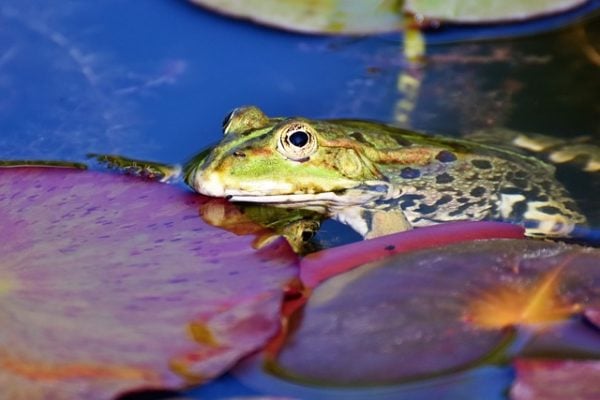
It is suggested that non-poisonous frogs be kept with turtles. Non-poisonous frogs to maintain with turtles are the Burmese Chubby, African Dwarf, American, Bumble Bee, Gray Tree, American Green Tree, Oriental Fire Bellied, Pacman, and Amazon Milk.
You may even maintain the famed dart frogs with these non-poisonous frogs. Dart frogs in the wild eat a diet high in chemicals. This causes them to accumulate poisons in their bodies. The captive dart frogs’ diet is devoid of such toxins, making them toxin-free.
Yes, your turtles would be secure if they eat captivity-bred dart frogs.
Dart frogs such as the Bumblebee Dart, Green Dart, and Black Dart are common dart frogs that you may keep with your turtles. However, before purchasing dart frogs, we recommend performing some study.
What Should You Do if You Own a Frog and a Turtle?
It’s impossible to dispute that having a turtle or a frog as a pet is a privilege. Both of these animals make excellent pets. In addition, many turtles and frogs are generally low-maintenance and easy to care for.
If you keep your pets together, there’s also a chance that one or both of them will be harmed. This is a circumstance that most pet owners should avoid at all costs. Understandably, you wouldn’t want your frog or turtle to be stressed or injured.
Frogs require a tank or aquarium with a capacity of 10-15 gallons. The temperature inside your frog’s tank must be between 77 and 82 degrees Fahrenheit. This depends on the kind of frog you have. You should keep the humidity between 60 and 80 percent. You must give them an adequate area to soak or swim, depending on the demands of the species. If your turtle is from 6 to 8 inches, you’ll need a tank with at least 50 gallons of water. Turtles require significantly more water than frogs. They also require more dry terrain in which to sunbathe, rest, and conceal. A pond with live flora and a substrate should always be present at the bottom of the water area. This is where your turtle digs. Not to mention shelters and basking spots in the turtle cage, like rocks or logs. Turtles require separate water bowls with clean drinking water. This must be away from their swimming pond. The water in the swimming pool must also be spring water. Chloride and fluoride are contaminants in tap water that might damage your pet.
How Do I Stop Them From Eating Each Other?
Frogs and turtles must not be housed in the same tank for the safety and health of the animals. A small tank is absolutely insufficient to accommodate both species. You could also have two tanks. One for frogs and one for turtles, if an outside pond is not possible for you, one for frogs and one for turtles. Pet owners should satisfy the demands of their animals. They can keep them happy and secure by keeping two separate tanks. It is essential to learn about what each species requires to live and what conditions. This may help you increase your frogs’ and turtles’ health and quality of life.
What Other Pets Can Live With Turtles?
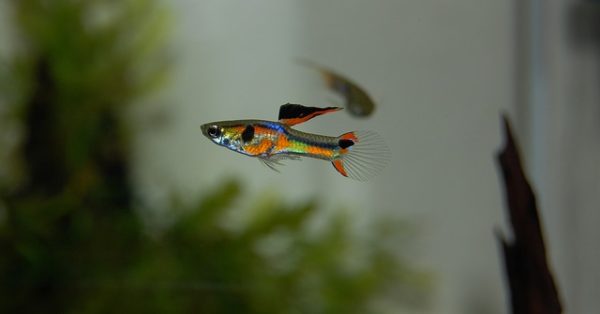
Guppies and other tiny, nimble fish may be able to coexist alongside turtles. However, they may overcrowd the tank. The goldfish and minnows are inexpensive. They are frequently maintained alongside turtles. If they are eaten, they may be simply and economically replenished.
Conclusion
Keeping these two together may appear to be a pleasant notion. However, it frequently ends in tragedy for one of the parties. Turtles are omnivores, meaning they eat everything. As a result, they will jump on the frogs and consume them right away. So there’s no assurance that if your turtles are kept together, they won’t devour frogs.
Another thing to remember from this piece is that both of these species demand distinct types of environments. Turtles require tanks. But, frogs require vivariums. If you placed both of them outside with a pond, they might be able to coexist and not have to cross paths.
No related posts.
